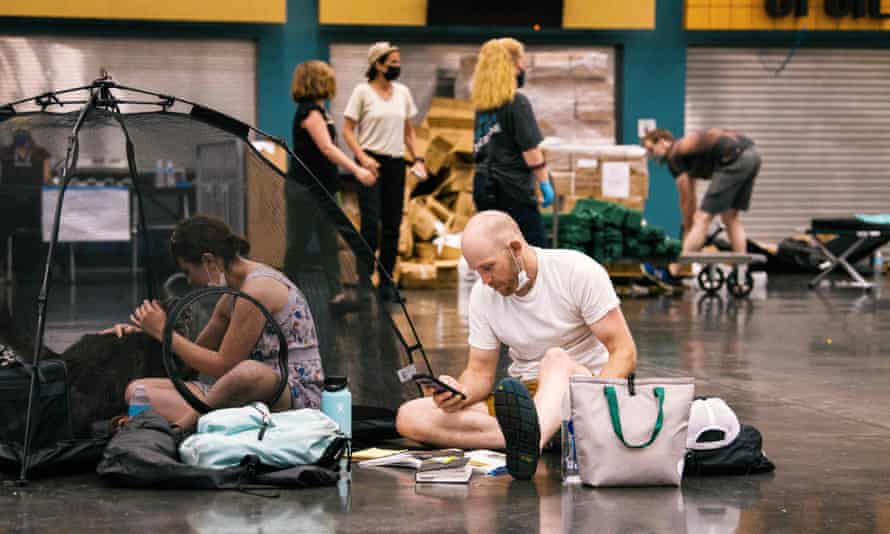Extract from The Guardian
Without an immediate global effort to combat the climate emergency, the Earth’s uninhabitable areas will keep growing.

People resting at a cooling station during a heatwave in Portland, Oregon, June 2021.
Thu 1 Jul 2021 00.35 AEST
Last modified on Thu 1 Jul 2021 06.39 AEST
The climate crisis means that summer is a time of increasingly dangerous heat. This week in the Pacific north-west, temperature records are not just being broken, they are being obliterated. Temperatures reached a shocking 47.9C in British Columbia, Canada. Amid temperatures more typically found in the Sahara desert, dozens have died of heat stress, with “roads buckling and power cables melting”.
Another heatwave earlier in June saw five Middle East countries top 50°C. The extreme heat reached Pakistan, where 20 children in one class were reported to have fallen unconscious and needed hospital treatment for heat stress. Thankfully, they all survived.
Additional warming from greenhouse gas emissions means that such extreme heatwaves are more likely and scientists can now calculate the increase in their probability. For example, the 2019 European heatwave that killed 2,500 people was five times more likely than it would have been without global warming.
While humans can survive temperatures of well over 50C when humidity is low, when both temperatures and humidity are high, neither sweating nor soaking ourselves can cool us. What matters is the “wet-bulb” temperature – given by a thermometer covered in a wet cloth – which shows the temperature at which evaporative cooling from sweat or water occurs. Humans cannot survive prolonged exposure to a wet-bulb temperature beyond 35C because there is no way to cool our bodies. Not even in the shade, and not even with unlimited water.
A 35C wet-bulb temperature was once thought impossible. But last year scientists reported that locations in the Persian Gulf and Pakistan’s Indus river valley had already reached this threshold, although only for an hour or two, and only over small areas. As climate change drives temperatures upwards, heatwaves and accompanying unliveable temperatures are predicted to last longer and occur over larger areas and in new locations, including parts of Africa and the US south-east, over the decades to come.
What can governments, companies and citizens do? First, cut off the supply of ever more extreme heatwaves by halving carbon dioxide emission this decade, then reaching net zero emissions by 2050.
Second, prepare for the inevitable heatwaves of the future. Emergency public health planning is the initial priority: getting essential information to people and moving vulnerable people into air-conditioned locations. Heatwave forecasts should include wet-bulb temperatures so that people can learn to understand the dangers.
Plans should account for the fact that heatwaves intensify structural inequalities. Poorer neighbourhoods typically have fewer green spaces and so heat up more, while outdoor workers, often poorly paid, are especially vulnerable. The rich also buy up cooling equipment at high prices once a heatwave is underway and have many more options to flee, underscoring the importance of public health planning.
Beyond crisis management, governments need to invest in making countries function in the new climate we are creating, including the extremes. In climate policy terms this is known as “adaptation”.
Of paramount importance is energy supplies being resilient to heatwaves, as people will be relying on electricity for cooling from air-conditioning units, fans and freezers, which are all life-savers in a heatwave. Similarly, internet communications and data centres need to be future-proofed, as these are essential services that can struggle in the heat.
Beyond this, new regulations are needed to allow buildings to keep cool and for transport systems, from roads to trains, to be able to operate under much higher temperature extremes.
Many of these changes can meet other challenges. Retro-fitting homes to be energy-efficient is also the perfect opportunity to modify them to also keep us cool. For example, installing electric heat pumps to warm houses in the winter means that in the summer they can also be switched to run in reverse to work as a cooling system. Cities can be kept cooler with green roofs and more green spaces, which also make them better places to live.
The final task is future-proofing agriculture and the wider ecosystems we all ultimately rely on. Heat can cause havoc with crop production. In Bangladesh, just two days of hot air in April this year destroyed 68,000 hectares of rice, affecting over 300,000 farmers with losses of US$39m (£28m). New heat-tolerant varieties of crops need developing and deploying. The alternative is higher food costs and food price spikes with the increased poverty and civil unrest that typically accompanies them.
Given these immense challenges how are governments doing on climate adaptation? Very poorly. The Paris agreement on climate change obliged countries to submit their adaptation plans, but only 13 countries have done so. One of those is the UK, but government plans were judged by its own independent advisors to have “failed to keep pace with the worsening reality of climate risk”.
The Glasgow Cop26 climate talks will need to put the spotlight on adaptation planning and funding for vulnerable countries. To curtail the impacts of ever more ferocious heatwaves, reducing emissions will need to go hand in hand with adapting to the swelteringly hot world we are creating. Stabilising the climate by 2050 is well within the timeframe of one working lifetime, as is adapting to allow us all to prosper in this new world. There is no time to lose.
Simon Lewis is professor of global change science at University College London and University of Leeds
No comments:
Post a Comment